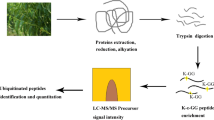Abstract
The timing and amplitude of plant signaling are frequently regulated through posttranslational modification of key signaling sectors, which facilitates rapid and flexible responses. Protein ubiquitination can serve as a degradation marker, influence subcellular localization, alter protein-protein interactions, and affect protein activity. Identification of polyubiquitinated proteins has been challenging due to their rapid degradation by the proteasome or removal of modifications by deubiquitination enzymes (DUBs). Tandem ubiquitin binding entities (TUBEs) are based on ubiquitin-associated domains and protect against both proteasomal degradation and DUBs. Here, we provide a protocol for purification of ubiquitinated plant proteins using TUBEs after transient expression in Nicotiana benthamiana. This protocol can also be applied to other plants to purify multiple ubiquitinated proteins or track ubiquitination of a target protein. This methodology provides an effective method for identification of ubiquitin ligase substrates and can be coupled with TUBEs targeting specific ubiquitination linkages.
Access this chapter
Tax calculation will be finalised at checkout
Purchases are for personal use only
Similar content being viewed by others
References
Kliza K, Husnjak K (2020) Resolving the Complexity of Ubiquitin Networks. Front Mol Biosci 7(21)
Clague MJ, Urbé S (2010) Ubiquitin: same molecule, different degradation pathways. Cell 143(5):682–685
Varshavsky A (2017) The ubiquitin system, autophagy, and regulated protein degradation. Annu Rev Biochem 86:123–128
Callis J (2014) The ubiquitination machinery of the ubiquitin system. Arabidopsis Book 12:e0174
Deol K, Lorenz S, Strieter ER (2019) Enzymatic logic of ubiquitin chain assembly. Front Physiol 10:835
Grubb LE et al (2021) Large-scale identification of ubiquitination sites on membrane-associated proteins in Arabidopsis thaliana seedlings. Plant Physiol 185(4):1483–1488
Udeshi ND et al (2013) Large-scale identification of ubiquitination sites by mass spectrometry. Nat Protoc 8(10):1950–1960
Reyes-Turcu FE, Ventii KH, Wilkinson KD (2009) Regulation and cellular roles of ubiquitin-specific deubiquitinating enzymes. Annu Rev Biochem 78:363–397
Hjerpe R et al (2009) Efficient protection and isolation of ubiquitylated proteins using tandem ubiquitin-binding entities. EMBO Rep 10(11):1250–1258
Lopitz-Otsoa F, Rodriguez MS, Aillet F (2010) Properties of natural and artificial proteins displaying multiple ubiquitin-binding domains. Biochem Soc Trans 38(1):40–45
Akinjiyan FA et al (2020) A Novel Luminescence-Based High-Throughput Approach for Cellular Resolution of Protein Ubiquitination Using Tandem Ubiquitin Binding Entities (TUBEs). SLAS DISCOVERY: Advancing the Science of Drug Discovery 25(4):350–360
Mattern M et al (2019) Using ubiquitin binders to decipher the ubiquitin code. Trends Biochem Sci 44(7):599–615
Lee D et al (2020) Regulation of reactive oxygen species during plant immunity through phosphorylation and ubiquitination of RBOHD. Nat Commun 11(1):1–16
Acknowledgments
GC and DH were supported by a grant from the National Institutes of Health (NIH 1R35GM136402).
Author information
Authors and Affiliations
Corresponding author
Editor information
Editors and Affiliations
Rights and permissions
Copyright information
© 2023 The Author(s), under exclusive license to Springer Science+Business Media, LLC, part of Springer Nature
About this protocol
Cite this protocol
Lee, D., Coaker, G. (2023). Purification and Detection of Ubiquitinated Plant Proteins Using Tandem Ubiquitin Binding Entities. In: Lois, L.M., Trujillo, M. (eds) Plant Proteostasis. Methods in Molecular Biology, vol 2581. Humana, New York, NY. https://doi.org/10.1007/978-1-0716-2784-6_17
Download citation
DOI: https://doi.org/10.1007/978-1-0716-2784-6_17
Published:
Publisher Name: Humana, New York, NY
Print ISBN: 978-1-0716-2783-9
Online ISBN: 978-1-0716-2784-6
eBook Packages: Springer Protocols




